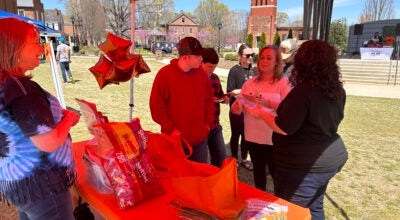Salisbury freight depot shows its age
Published 12:00 am Sunday, September 25, 2011
SALISBURY — Susan Goodman Sides and Charlie Peacock know a gem of a building when they see one.
So they rightly appreciate the century-old freight depot standing alone these days in the “Y” (railroaders might call it the “wye”) formed by the tracks going north-south and west just off North Lee Street.
The circa 1910 depot, closed up for several years now, is just north of an edge of the Old Lutheran Cemetery.
You can see the building from two crossings: from the Kerr Street crossing, look north, and it stands next to the tracks on the left, a couple hundred yards away. From the Henderson Street crossing, look south, and it will be just down the tracks on your right.
It’s a spot where retired railroaders sometimes come to sit in their cars and watch the day’s trains go by. Most recently, I think, Thomas and Howard had leased the structure for its cash-and-carry grocery wholesale business.
One day last week, Sides and Peacock drove to the freight depot after lunch at Richard’s, just to look at the building from the outside.
Eight shipping doors are on the side facing the big parking lot and North Lee Street. People coming to pick up their order, which came in by LCL shipments (less-than-carload lots) would go to the office and be told which of the eight bays to back into for delivery.
The office was on the south end.
Likewise, on the side of the building next to the tracks, LCL goods from local freight trains were moved into the depot through similar bays.
“It used to be a beehive of activity for years and years,” Peacock recalls.
He pointed to a car ramp still existing on the north side of the building. New vehicles for dealerships in Salisbury would arrive here four to a freight car.
Peacock remembers coming here as a young man to see his 1946 Nash roll off the train before going on to the dealership.
“I was so excited, I came down and watched them unload it,” he says.
Peacock judges that this local freight depot, as with others throughout the country, stayed busy at least into the 1950s until LCLs became a thing of the past.
In the mid 1920s, for example, some 75 percent to 85 percent of intercity freight moved by rail, and a great bulk of the freight traveled in less-than-carload lots.
Salisbury businesses such as the Snider Brothers, Swicegood Paper Co. and Fleming Candy, or farming operations needing seeds and tools, or local factories requiring special parts for machinery often picked their orders up at the freight depot after they came in as part of less-than-carload shipments.
Most of these businesses relying on the freight depot also were those not big enough to have their own rail siding.
The small wholesale grocer might want only 40 cases of coffee, not a whole boxcar load. His coffee would come to the Salisbury freight depot in a boxcar filled with items for other people and businesses.
Residents making big catalog purchases through Sears or Montgomery Ward — bulky things like new kitchen stoves — also might find themselves picking up their orders at the freight depot.
The Spencer transfer sheds were the backbone for the LCL shipments to individual towns and cities along the rails in the central Piedmont.
Boxcars coming in on the main line had to be parked at sheds, where an army of workers would unload the contents and sort things into LCL boxcars going out by local freight trains to places such as Salisbury.
“Even Landis had a freight office,” Peacock says.
In Salisbury, the 1722 switch engine would move the LCL cars where they had to be for unloading.
Peacock remembers the transfer shed up the line employing close to 300 people at one time. “Of course, this is all gone,” he laments.
As for today’s lonely freight depot, the railroad still owns it, and while the building is worthy of saving, coming up with the necessary funds not just to purchase it but to stabilize, renovate and possibly resell it would be a tremendous undertaking.
“You see,” says Peacock, looking toward the building, “it’s in pretty bad shape. It would take a fortune.”
Sides, president of Historic Salisbury Foundation, knows this, but she can’t resist being interested enough to make some inquiries. HSF has a close connection to the railroad, of course, given its home at the 1908 passenger depot.
“We’ll get the keys and look at it,” she says on the freight depot’s behalf.
If old buildings could cry, this one just did.
Contact Mark Wineka at 704-797-4263, or mwineka@salisburypost.com




